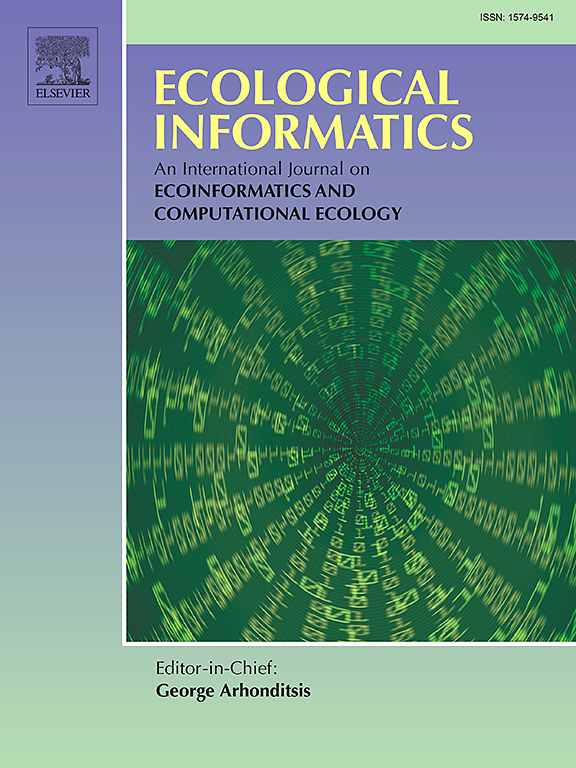Simulation and control of the cyanobacterial bloom biomass in a typical plateau lake based on the logistic growth model: A case study of Xingyun Lake
IF 5.8
2区 环境科学与生态学
Q1 ECOLOGY
引用次数: 0
Abstract
The simulation and early warning of cyanobacterial blooms in lakes are of great significance. Controlling the growth of cyanobacteria in plateau lakes is challenging due to the unique geographical environment, climatic conditions, and impact of anthropogenic activities. Therefore, conducting simulations and early warning is crucial to effectively control cyanobacterial blooms in plateau lakes. This study aimed to investigate Xingyun Lake, a representative plateau lake in China, using the logistic growth model to analyze cyanobacterial growth patterns and assess the effects of control projects, along with the influence of meteorological and environmental factors. Moreover, the study proposed a method for establishing control curves and ranges for managing cyanobacterial blooms. The results demonstrated that the chlorophyll-a concentration in the effluent decreased by an average of 97.74% compared with that in the influent after implementing the integrated “deep-well pressure algal control” and “ecological purification for algae-water separation” processes in Xingyun Lake. The total annual decrease in chlorophyll-a was approximately 3.40 times the lake's total chlorophyll-a content. The growth of cyanobacteria in Xingyun Lake followed a logistic pattern during the blooming period, before and after implementing control projects (from 2018 to 2022), with the overall growth trend from 2010 to 2022 aligning with the logistic growth model. The study identified lower temperatures and precipitation, reduced nitrogen and phosphorus loads, and a higher nitrogen-to‑phosphorus ratio as the main environmental factors inhibiting cyanobacterial growth. Establishing logistic control curves for cyanobacterial blooms and sustaining the algal control project before the transition point effectively reduced the maximum chlorophyll-a concentration and attenuated cyanobacterial growth rate throughout the year. This study offered novel perspectives for preventing and controlling cyanobacterial blooms, offering practical guidance for lake management, especially in plateau regions.基于逻辑生长模型的典型高原湖泊蓝藻水华生物量模拟与控制兴云湖案例研究
模拟和预警湖泊中的蓝藻水华意义重大。由于独特的地理环境、气候条件以及人为活动的影响,控制高原湖泊蓝藻的生长具有很大的挑战性。因此,进行模拟和预警对于有效控制高原湖泊蓝藻水华至关重要。本研究以中国具有代表性的高原湖泊--星云湖为研究对象,利用逻辑生长模型分析蓝藻的生长规律,并结合气象和环境因素的影响,评估控制工程的效果。此外,该研究还提出了建立蓝藻水华控制曲线和控制范围的方法。结果表明,在兴云湖实施 "深井压力控藻 "和 "藻水分离生态净化 "综合工艺后,出水叶绿素-a 浓度比进水平均下降 97.74%。叶绿素-a 的年总降幅约为湖泊叶绿素-a 总含量的 3.40 倍。在实施治理工程前后(2018 年至 2022 年)的蓝藻盛发期,兴云湖蓝藻的生长遵循逻辑规律,2010 年至 2022 年的总体生长趋势与逻辑生长模型一致。研究发现,气温和降水量降低、氮和磷负荷减少以及氮磷比升高是抑制蓝藻生长的主要环境因素。建立蓝藻水华的逻辑控制曲线,并在过渡点之前持续实施藻类控制项目,可有效降低叶绿素-a 的最大浓度,并减缓蓝藻全年的生长速度。该研究为预防和控制蓝藻水华提供了新的视角,为湖泊管理,尤其是高原地区的湖泊管理提供了实际指导。
本文章由计算机程序翻译,如有差异,请以英文原文为准。
求助全文
约1分钟内获得全文
求助全文
来源期刊

Ecological Informatics
环境科学-生态学
CiteScore
8.30
自引率
11.80%
发文量
346
审稿时长
46 days
期刊介绍:
The journal Ecological Informatics is devoted to the publication of high quality, peer-reviewed articles on all aspects of computational ecology, data science and biogeography. The scope of the journal takes into account the data-intensive nature of ecology, the growing capacity of information technology to access, harness and leverage complex data as well as the critical need for informing sustainable management in view of global environmental and climate change.
The nature of the journal is interdisciplinary at the crossover between ecology and informatics. It focuses on novel concepts and techniques for image- and genome-based monitoring and interpretation, sensor- and multimedia-based data acquisition, internet-based data archiving and sharing, data assimilation, modelling and prediction of ecological data.
 求助内容:
求助内容: 应助结果提醒方式:
应助结果提醒方式:


